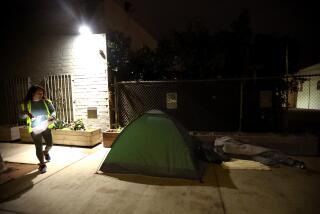Editorial: Forget the shelter in Antelope Valley; concentrate on real housing for homeless people
It was alarming to see the Lancaster Community Shelter, the only source of nightly housing for homeless people in the Antelope Valley, close on Monday. In this high-desert area where temperatures soar on summer days and plummet on winter nights, the 104-bed shelter often had to turn away at least a dozen people looking for a bed.
Fortunately, the Los Angeles Homeless Services Authority and a cadre of nonprofit service providers scrambled and relocated the people who used the shelter. The closure also accelerated the effort to bring together county and Antelope Valley officials, nonprofits and the Homeless Services Authority to map out a substantial, long-term approach to getting people in this area out of homelessness for good. If it bears fruit, that long-needed effort will be the best outcome of this emergency.
The nonprofit Grace Resources may have run the shelter with the best of intentions, but it was never going to offer a path out of homelessness for its nightly residents. L.A. County Supervisor Kathryn Barger, who represents this area, and fellow Supervisor Mark-Ridley Thomas had already begun to put together a consortium to tackle homelessness in the Antelope Valley, where nearly 4,500 homeless people were found in this year’s count — up 50% from the year before.
The shelter closing didn’t make homelessness an urgent problem. It’s been an urgent problem in this area — as in the rest of Los Angeles County.
Homelessness is as organic to the Antelope Valley as it is to the city of L.A.
Here is where the consortium should start: by helping the handful of nonprofit service providers already in the area function better financially and expand where they can; by growing new community-based organizations; and by recruiting established providers to the area. Lancaster Mayor R. Rex Parris, who has made no secret of his dislike for some of the current service providers, can take a more constructive leadership role here. There are plenty of respected service providers throughout the county. He should reach out to some, see if he can work with them — and they with him — and invite them to Lancaster.
Like elsewhere in the county, both short-term and permanent supportive housing in the Antelope Valley are scarce but crucial. Officials and nonprofits need to scour the area for housing that can help homeless people making the transition from the streets to permanent housing, including apartments, motel rooms and hotel rooms. Barger’s office compiled a list of different prospects, most of them identified by the Valley Oasis service provider in the Antelope Valley. Now the supervisor needs to put her clout into getting landlords to work with service providers to make sure homeless people really get housed.
Everyone has a part to play in this — the supervisor, the elected officials of Lancaster and Palmdale, the nonprofits, LAHSA and local residents. We can debate whether Barger’s predecessor, Mike Antonovich — for whom she served as chief of staff — should have done more about homelessness in the Antelope Valley a few years ago; regardless, the problem is now Barger’s to tackle. So far, at least, she’s winning kudos in this seemingly disconnected part of the county, where local officials feel alienated from and disrespected by L.A. County power brokers.
So with that kind of goodwill in place and the beginnings of a plan, Barger should let nothing stop her from powering through on this with focus and urgency and getting more people permanently housed.
Yes, the communities of Antelope Valley need to be involved in this. But people need to realize, first and foremost, that making a dent in homelessness means having homeless people living and working successfully in their communities. Anyone who believes that closing the Grace Resources shelter near downtown Lancaster meant that homeless people would somehow vanish into the desert — or another city — doesn’t grasp that homelessness is as organic to the Antelope Valley as it is to the city of L.A.
Parris says he understands that homeless people only escape that scourge when they have long-term housing and services. He and other elected officials in the Antelope Valley need to make clear to their constituents that the way to deal with homeless people is to concentrate on providing them long-term housing, not fixating on how they got there.
Follow the Opinion section on Twitter @latimesopinion or Facebook
More to Read
A cure for the common opinion
Get thought-provoking perspectives with our weekly newsletter.
You may occasionally receive promotional content from the Los Angeles Times.










